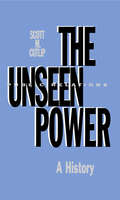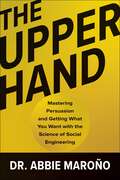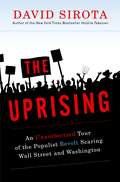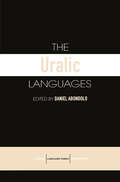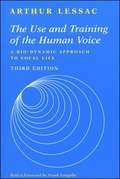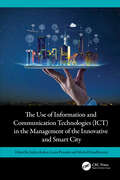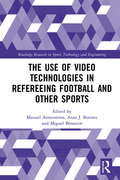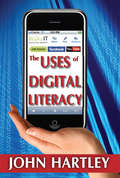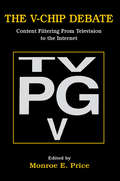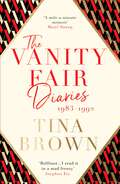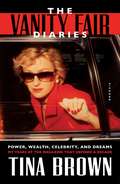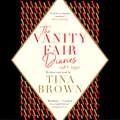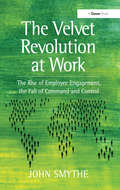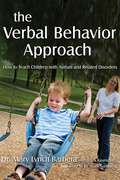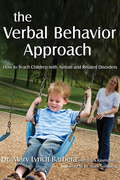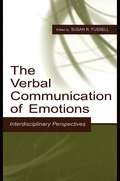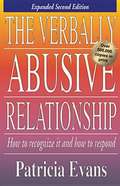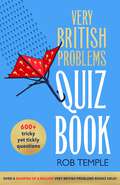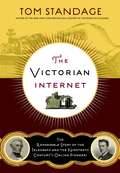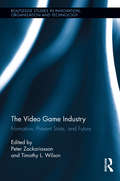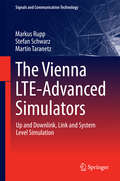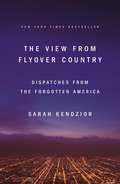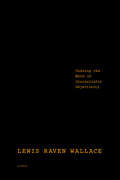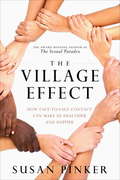- Table View
- List View
The Unseen Power: A History (Routledge Communication Series)
by Scott M. CutlipBased largely on primary sources, this book presents the first detailed history of public relations from 1900 through the 1960s. The author utilized the personal papers of John Price Jones, Ivy L. Lee, Harry Bruno, William Baldwin III, John W. Hill, Earl Newsom as well as extensive interviews -- conducted by the author himself -- with Pendleton Dudley, T.J. Ross, Edward L. Bernays, Harry Bruno, William Baldwin, and more. Consequently, the book provides practitioners, scholars, and students with a realistic inside view of the way public relations has developed and been practiced in the United States since its beginnings in mid-1900. For example, the book tells how: * President Roosevelt's reforms of the Square Deal brought the first publicity agencies to the nation's capital. * Edward L. Bernays, Ivy Lee, and Albert Lasker made it socially acceptable for women to smoke in the 1920s. * William Baldwin III saved the now traditional Macy's Thanksgiving Day parade in its infancy. * Ben Sonnenberg took Pepperidge Farm bread from a small town Connecticut bakery to the nation's supermarket shelves -- and made millions doing it. * Two Atlanta publicists, Edward Clark and Bessie Tyler, took a defunct Atlanta bottle club, the Ku Klux Klan, in 1920 and boomed it into a hate organization of three million members in three years, and made themselves rich in the process. * Earl Newsom failed to turn mighty General Motors around when it was besieged by Ralph Nader and Congressional advocates of auto safety. This book documents the tremendous role public relations practitioners play in our nation's economic, social, and political affairs -- a role that goes generally unseen and unobserved by the average citizen whose life is affected in so many ways by the some 150,000 public relations practitioners.
The Upper Hand: Mastering Persuasion and Getting What You Want with the Science of Social Engineering
by Dr. Abbie MaroñoLearn to get what you want from others and build stronger relationships by replacing coercive tactics with this social science-backed playbook for winning trust. Having leverage—in the form of intelligence, charm, beauty, money, status, or insider knowledge—often gives you an advantage in an interaction. When it doesn&’t, or when you don&’t have any, people often turn to tricks and schemes that run the risk of damaging personal relationships. In The Upper Hand human behavioral scientist and sought-after speaker, advisor, and coach Dr. Abbie Maroño shows you how to influence people and situations in your favor with skill and integrity—and without the need for leverage or coercion. Based on principles of prosocial engineering, Dr. Abbie shows you how to build and maintain trust by gaining an understanding of the psychological mechanisms underpinning human decision making. She presents five key truths about the complexity of human behavior that you can count on one hand to give you the upper hand: we are our brains we are driven to survive (by any means necessary) we want to connect and cooperate we have a mind-body feedback loop we want to protect our self-identity By grasping how these truths are at play—and learning to see how they show up differently based on cultural contexts, individual differences, and situational dynamics—you&’ll be primed to tailor an informed approach to influencing outcomes when it matters most. Personal connections are key to getting what we want—whether moving up in our careers, attracting customers, or maintaining romantic partnerships. The Upper Hand is your indispensable guide to building trust and cooperation on your way to getting what you want, whatever it may be.
The Uprising: An Unauthorized Tour of the Populist Revolt Scaring Wall Street and Washington
by David Sirota[From the book jacket] An All-Access Pass to the Populist Insurrection Brewing Across the Country Job outsourcing. Perpetual busy signals at government agencies. Slashed paychecks. Stolen elections. A war without end, fatally mismanaged. Ordinary Americans on both the Right and Left are tired of being disenfranchised by corrupt politicians of both parties and are organizing to change the status quo. In his invigorating new book, David Sirota investigates whether this uprising can be transformed into a unified, lasting political movement. Throughout the course of American history, uprisings like the one we are seeing now have given birth to powerful movements to end wars, protect workers, and expand civil rights, so the prospect of today's uprising turning into a full- fledged populist movement terrifies Wall Street and Washington. In The Uprising, Sirota takes us far from the national media spotlight into the trenches where real change is happening - from the headquarters of the most powerful third party in America to the bowels of the U.S. Senate; from the auditorium of an ExxonMobil shareholder meeting to the quasi-military staging area of a vigilante force on the Mexican border. This is vital, on-the-ground reporting that immerses us in the tumultuous give-and-take of politics at its most personal. Sirota also offers a biting critique of our politics. He shows how the uprising is, at its core, a reaction to faux "bipartisanship" in the nation's capital - the "bipartisanship" whereby Republican and Democratic lawmakers join together in putting the agenda of corporate interests above all those of ordinary citizens. Ultimately, Sirota reminds us that the Declaration of Independence, "America's original uprising manifesto," says that governments "derive their powers from the consent of the governed." Irreverent and insightful, The Uprising shows how the governed have stopped consenting and have started taking action.
The Uralic Languages (Routledge Language Family Series)
by Daniel AbondoloThis book provides a unique, up-to-date survey of individual Uralic languages and sub-groupings from Finnish to Selkup.Spoken by more than 25 million native speakers, the Uralic languages have important cultural and social significance in Northern and Eastern Europe, as well as in immigrant communitites throughout Europe and North America. The introductory chapter gives an overview of the Uralic language family and is followed by 18 chapter-length descriptions of each language or sub-grouping, giving an analysis of their history and development as well as focusing on their linguistic structures.Written by internationally recognised experts and based on the most recent scholarship available, the volume covers major languages - including the official national languages of Estonia, Finland and Hungary - and rarely-covered languages such as Mordva, Nganasan and Khanty. The 18 language chapters are similarly-structured, designed for comparative study and cover phonology, morphology, syntax and lexicon. Those on individual languages also have sample text where available. Each chapter includes numerous tables to support and illustrate the text and bibliographies of the major references for each language to aid further study. The volume is comprehensively indexed.This book will be invaluable to language students, experts requiring concise but thorough information on related languages and anyone working in historical, typological and comparative linguistics.
The Use And Training Of The Human Voice: A Bio-dynamic Approach To Vocal Life
by Frank Langella Arthur LessacThis introductory text details Arthur Lessac’s proven procedures for understanding, training, and improving the voice and speech of the performer by exploring the varied qualities of the physical energies associated with producing sounds.
The Use of Information and Communication Technologies (ICT) in the Management of the Innovative and Smart City
by Judyta Kabus Luiza Piersiala Michał DziadkiewiczKey elements in the formation of smart cities are development based on cooperation between local governments and business, the realization of sustainable development goals, the creation of social sustainability, the advancement of information and communication technologies (ICT) and the use of innovative solutions. The theories of information and communication have become the main driver of economic development in a globalized world and the information component plays a key role in building the competitive potential of countries and cities.The purpose of this book is to systematize knowledge about the practical application and importance of innovative solutions in the economic and social fields. An important aspect of this edition is the presentation of innovations applied in the field of conservation, not only of energy or environmental resources, but also of economic, social and spatial resources. We propose that this edition provides a knowledge base on the basic concepts of corporate social responsibility (CSR), formulating the important role of management in the context of CSR, smart management, smart economy and smart cities.The book is a comprehensive study of the smart city concept in its broadest sense, covering environmental, social and economic issues.It will be helpful to professionals in companies, in logistics departments and in the management teams. It can be useful for practitioners and analysts in the transportation industry to expand applications of ICT solutions. It will also be valuable to researchers, doctoral students of economics in management and entrepreneurship, logistics, as well as students at the advanced level, as it brings a range of valuable information that can serve as base material and reference for further research, programmes and studies.
The Use of Video Technologies in Refereeing Football and Other Sports (Routledge Research in Sports Technology and Engineering)
by Manuel Armenteros Anto J. Benitez Miguel Ángel BetancorFor a long time, various different lobbying sectors have claimed that the use of video technology is an effective aid in decision-making. Now the IFAB has taken a historic step in the approval of experiments on the use of video to provide support to football refereeing. The Use of Video Technologies in Refereeing Football and Other Sports analyses the capacity of audio-visual technology from different perspectives to help understand the best implementation of the Video Assistant Referee (VAR) system in football and, more generally, in other sports. This book addresses in-depth interdisciplinary viewpoints on the need and the opportunity of the implementation procedures regarding how to use it, considering that it could lead to very important changes. The book goes on to examine various approaches to the most interesting topics for players, amateurs, coaches, referees and referees coaches. Offering viewpoints from both academics and professionals, this new volume addresses the VAR issue in a multidisciplinary way, analysing the implications of video replay application in football from the perspective of players, coaches, television professionals, referees, amateurs, sports lawyers, media and educators.
The Uses of Digital Literacy (Creative Economy + Innovation Culture Ser.)
by John HartleyAt the heart of this book lies a reappraisal of humanities research and its use in understanding the conditions of a consumer-led society. This is an open, investigative, critical, scientific task as well as an opportunity to engage with creative enterprise and culture. Now that every user is a publisher, consumption needs to be rethought as action not behavior, and media consumption as a mode of literacy.Online social networks and participatory media are often still ignored by professionals, denounced in the press and banned in schools. But the potential of digital literacy should not be underestimated. Fifty years after Richard Hoggart's pioneering The Uses of Literacy reshaped the educational response to popular culture, John Hartley extends Hoggart's argument into digital media. Media evolution has made possible the realism of the modern age journalism, the novel and science not to mention mass entertainment on a global scale.Hartley reassesses the historical and global context, commercial and cultural dynamics and the potential of popular productivity through analysis of the use of digital media in various domains, including creative industries, digital storytelling, YouTube, journalism, and mediated fashion. Encouraging mass participation in the evolutionary growth of knowledge, The Uses of Digital Literacy shows how today's teenage fad may become tomorrow's scientific method. Hartley claims the time has come for education to catch up with entertainment and for the professionals to learn from popular culture. This book will stimulate the imagination and stir further research.
The V-chip Debate: Content Filtering From Television To the Internet (Routledge Communication Series)
by Monroe E. PriceThe V-chip is a highly significant part of the discussion about whether television (or broadcasting in general) deserves some special attention in terms of its accessibility to children, its particular power to affect conduct, and its invasiveness. But as this notion of filtering and labeling has caught the imagination of the regulator, the legislator, and all those who wish to consider new ways to alter bargaining over imagery in society, the very idea of the V-chip or its equivalent is moving across other technologies, including the Internet. The V-chip issue has also fueled the ongoing debate about violence and sexual practices in society, and how representations on television relate to those practices. Although the initial concept of the V-chip is simple, its flow into the public realm raises so many extraordinary questions that the introduction and production of the chip virtually serves as a case study in problems of law and public policy. The very conceptualization of speech in society is being affected by this issue. Accordingly, the place of the V-chip in this debate is increasingly important; indeed, it may be argued that the V-chip's contribution to legal argumentation may be greater than its ultimate contribution to the relationship between children and imagery. Among the questions the contributors address are: *What research basis is necessary to require a framework for labeling and rating? *What relationship between government and the image-producing industries can be characterized--for constitutional and other reasons--as voluntary as opposed to coercive? *Who should evaluate these images? *To what extent should the evaluation process be centralized and/or distributed? *What assessment is appropriate to evaluate whether the experiment is "successful?" In addition to the V-chip's origin's in Canada and its further evolution in the United States, this book discusses the development of the V-chip and television rating systems in Europe, Australia, and throughout the world. It also includes essays which contrast the very different approaches in Canada and the United States in terms of the role of regulatory agency, industry, and government.
The Vanity Fair Diaries: 1983 - 1992
by Tina Brown'Indiscreet, brilliantly observed, frequently hilarious' Evening Standard'Hang on - it's a wild ride' Meryl StreepIt's 1983. A young Englishwoman arrives in Manhattan on a mission. Summoned in the hope that she can save Condé Nast's troubled new flagship Vanity Fair, Tina Brown is plunged into the maelstrom of competitive New York media. She survives the politics and the intrigue by a simple stratagem: succeeding. Here are the inside stories of the scoops and covers that sold millions: the Reagan kiss, the meltdown of Princess Diana's marriage to Prince Charles, the sensational Annie Leibovitz cover of a gloriously pregnant, naked Demi Moore. Written with dash and verve, the diary is also a sharply observed account of New York and London society. In its cinematic pages the drama, comedy and struggle of raising a family and running an 'it' magazine come to life.
The Vanity Fair Diaries: 1983 - 1992
by Tina BrownNamed one of the best books of 2017 by Time, People, The Guardian, Paste Magazine, The Economist, Entertainment Weekly, & VogueTina Brown kept delicious daily diaries throughout her eight spectacular years as editor-in-chief of Vanity Fair. Today they provide an incendiary portrait of the flash and dash and power brokering of the Excessive Eighties in New York and Hollywood.The Vanity Fair Diaries is the story of an Englishwoman barely out of her twenties who arrives in New York City with a dream. Summoned from London in hopes that she can save Condé Nast's troubled new flagship Vanity Fair, Tina Brown is immediately plunged into the maelstrom of the competitive New York media world and the backstabbing rivalries at the court of the planet's slickest, most glamour-focused magazine company. She survives the politics, the intrigue, and the attempts to derail her by a simple stratagem: succeeding. In the face of rampant skepticism, she triumphantly reinvents a failing magazine.Here are the inside stories of Vanity Fair scoops and covers that sold millions—the Reagan kiss, the meltdown of Princess Diana's marriage to Prince Charles, the sensational Annie Leibovitz cover of a gloriously pregnant, naked Demi Moore. In the diary's cinematic pages, the drama, the comedy, and the struggle of running an "it" magazine come to life. Brown's Vanity Fair Diaries is also a woman's journey, of making a home in a new country and of the deep bonds with her husband, their prematurely born son, and their daughter.Astute, open-hearted, often riotously funny, Tina Brown's The Vanity Fair Diaries is a compulsively fascinating and intimate chronicle of a woman's life in a glittering era.
The Vanity Fair Diaries: 1983–1992
by Tina BrownTina Brown kept delicious daily diaries throughout her eight spectacular years as editor-in-chief of Vanity Fair. Today they provide an incendiary portrait of the flash and dash and power brokering of the Excessive Eighties in New York and Hollywood.'A fabulous odyssey ... I read it in a mad frenzy' Stephen Fry'Full of creative glee, passion and wild-ride excitement' Simon Schama'Hang on - it's a wild ride' Meryl StreepThe Vanity Fair Diaries is the story of an Englishwoman barely out of her twenties who arrives in New York City with a dream. Summoned from London in hopes that she can save Condé Nast's troubled new flagship Vanity Fair, Tina Brown is immediately plunged into the maelstrom of the competitive New York media world and the backstabbing rivalries at the court of the planet's slickest, most glamour-focused magazine company. She survives the politics, the intrigue and the attempts to derail her by a simple stratagem: succeeding. In the face of rampant skepticism, she triumphantly reinvents a failing magazine.Here are the inside stories of Vanity Fair scoops and covers that sold millions: the Reagan kiss, the meltdown of Princess Diana's marriage to Prince Charles, the sensational Annie Leibovitz cover of a gloriously pregnant, naked Demi Moore. In the diary's cinematic pages, the drama, comedy and struggle of running an 'it' magazine come to life. Brown's Vanity Fair Diaries is also a woman's journey, of making a home in a new country and of the deep bonds with her husband, their prematurely born son and their daughter.Astute, open-hearted, often riotously funny, Tina Brown's The Vanity Fair Diaries is a compulsively fascinating and intimate chronicle of a woman's life in a glittering era.(p) Macmillan US 2017 Written and Read by Tina Brown
The Velvet Revolution at Work: The Rise of Employee Engagement, the Fall of Command and Control
by John SmytheWhat drives or delivers engaged people? Employers need to focus on creating the right conditions. Employers can't impose engagement: people need to choose to engage themselves. In The Velvet Revolution at Work, the follow-up to his best-selling The CEO: Chief Engagement Officer, John Smythe explains that the essential ingredient of the right conditions is a culture of distributed leadership which enables people at work to liberate their creativity to deliver surprisingly good results for their institution and themselves. Using models, examples and anecdotes from his client research he goes on to demonstrate exactly how to design an engagement process; one that is integrated with your business strategy and that is sustainable.
The Verbal Behavior Approach: How to Teach Children with Autism and Related Disorders
by Mary Lynch Barbera Tracy RasmussenThe Verbal Behavior (VB) approach is a form of Applied Behavior Analysis (ABA), that is based on B.F. Skinner's analysis of verbal behavior and works particularly well with children with minimal or no speech abilities. In this book Dr. Mary Lynch Barbera draws on her own experiences as a Board Certified Behavior Analyst and also as a parent of a child with autism to explain VB and how to use it. This step-by-step guide provides an abundance of information about how to help children develop better language and speaking skills, and also explains how to teach non-vocal children to use sign language. An entire chapter focuses on ways to reduce problem behavior, and there is also useful information on teaching toileting and other important self-help skills, that would benefit any child. This book will enable parents and professionals unfamiliar with the principles of ABA and VB to get started immediately using the Verbal Behavior approach to teach children with autism and related disorders.
The Verbal Behavior Approach: How to Teach Children with Autism and Related Disorders
by Mary Lynch BarberaA step-by-step guide on how to help children develop language and speaking skills.The Verbal Behavior (VB) approach is a form of Applied Behavior Analysis (ABA), that is based on B.F. Skinner's analysis of verbal behavior and works particularly well with children with minimal or no speech abilities. In this book Dr. Mary Lynch Barbera draws on her own experiences as a Board Certified Behavior Analyst and also as a parent of a child with autism to explain VB and how to use it.This step-by-step guide provides an abundance of information about how to help children develop better language and speaking skills, and also explains how to teach non-vocal children to use sign language. An entire chapter focuses on ways to reduce problem behavior, and there is also useful information on teaching toileting and other important self-help skills, that would benefit any child.This book will enable parents and professionals unfamiliar with the principles of ABA and VB to get started immediately using the Verbal Behavior approach to teach children with autism and related disorders.(P)2017 Hodder & Stoughton Limited
The Verbal Communication of Emotions: Interdisciplinary Perspectives
by Susan R. FussellThis book pulls together new research and theory on the verbal communication of emotions by an international, cross-disciplinary group of recognized experts in affective communication. The book's goal is to provide readers with a comprehensive view of current research and encourage cross-disciplinary interaction. Topics include analyses of literal and figurative expressions for emotions, studies of the use of metaphor and other figurative expressions for emotion, analysis of the role of conversational partners in creating emotional meaning, and the effects of culture on emotional communication. The chapters are organized into three broad areas: background theory, figurative language use, and social/cultural aspects of emotional communication. Part I reviews fundamental issues in the verbal communication of emotion. Part II examines the role of metaphor and other figures of speech in emotional communication in both everyday language and psychotherapeutic contexts. Part III looks at ways emotions are embedded in larger socio-culture processes. Taken as a whole, the chapters provide a comprehensive look at the current state of research on the use of language in affective communication and suggest a number of interesting directions for future research.
The Verbally Abusive Relationship: How to Recognize It and How to Respond
by Patricia EvansVerbal abuse doesn't leave the same physical evidence as battery, but it can be just as painful, and can actually take longer to recover from. The new edition of this important reference covers the most recent developments in dealing with verbal abuse and answers the questions readers ask most on the subject.
The Very British Problems Quiz Book
by Rob TempleWhat does 'custard and jelly' mean in cockney rhyming slang?Which biscuit has half of its name on top of the cooker and the other half on the door?And 25 million of what drink are served by British Airways each year?We Brits can't get enough of a quiz. Stumped for office party chit-chat? Quiz. Midweek visit to the pub? Quiz. Stuck inside in pyjamas on a rainy night and in the mood to cause a big family argument? You got it - quiz.This book is correspondingly filled with questions on all things wonderfully and unequivocally British - you'll find all sorts of tickly teasers, complex conundrums, worrisome word searches and much more on topics ranging from our iconic weather to types of cake. Best enjoyed with a cup of tea and your favourite biscuit(s).***ANSWERS: Telly, Hobnob, buy the book and find out!***Praise for Very British Problems'Had us guffawing into our Earl Grey tea' Bella'My favourite twitter account at the moment is Very British Problems (@soverybritish) . . . it makes me laugh out loud' Tom Hiddleston'Hilarious' Daily Express'Temple pays affectionate and comic homage to the sheer quirkiness of being British' Good Book Guide
The Very British Problems Quiz Book
by Rob TempleWhat does 'custard and jelly' mean in cockney rhyming slang?Which biscuit has half of its name on top of the cooker and the other half on the door?And 25 million of what drink are served by British Airways each year?We Brits can't get enough of a quiz. Stumped for office party chit-chat? Quiz. Midweek visit to the pub? Quiz. Stuck inside in pyjamas on a rainy night and in the mood to cause a big family argument? You got it - quiz.This book is correspondingly filled with questions on all things wonderfully and unequivocally British - you'll find all sorts of tickly teasers, complex conundrums, worrisome word searches and much more on topics ranging from our iconic weather to types of cake. Best enjoyed with a cup of tea and your favourite biscuit(s).***ANSWERS: Telly, Hobnob, buy the book and find out!***Praise for Very British Problems'Had us guffawing into our Earl Grey tea' Bella'My favourite twitter account at the moment is Very British Problems (@soverybritish) . . . it makes me laugh out loud' Tom Hiddleston'Hilarious' Daily Express'Temple pays affectionate and comic homage to the sheer quirkiness of being British' Good Book Guide
The Victorian Internet: The Remarkable Story of the Telegraph and the Nineteenth Century's On-line Pioneers
by Tom Standagehe Victorian Internet tells the colorful story of the telegraph's creation and remarkable impact, and of the visionaries, oddballs, and eccentrics who pioneered it, from the eighteenth-century French scientist Jean-Antoine Nollet to Samuel F. B. Morse and Thomas Edison.
The Video Game Industry: Formation, Present State, and Future (Routledge Studies in Innovation, Organizations and Technology)
by Edited by Peter Zackariasson Timothy L. WilsonThe Video Game Industry provides a platform for the research on the video game industry to draw a coherent and informative picture of this industry. Previously this has been done sparsely through conference papers, research articles, and popular science books. Although the study of this industry is still stigmatized as frivolous and ‘only’ game oriented, those who grew up with video games are changing things, especially research agendas, the acceptance of studies, and their interpretation. This book describes and defines video games as their own special medium. They are not pinball from which they grew, nor movies which they sometimes resemble. They are a unique form of entertainment based on meaningful interactions between individuals and machine across a growing sector of the population. The Video Game Industry provides a reference foundation for individuals seriously interested in the industry at the academic level. As a result, this book will serve as a reference in curricula associated with video game development for years to come.
The Vienna LTE-Advanced Simulators
by Markus Rupp Stefan Schwarz Martin TaranetzThis book introducesthe Vienna Simulator Suite for 3rd-Generation Partnership Project(3GPP)-compatible Long Term Evolution-Advanced (LTE-A) simulators and presentsapplications to demonstrate their uses for describing, designing, and optimizingwireless cellular LTE-A networks. Part One addresses LTEand LTE-A link level techniques. As there has been high demand for the downlink(DL) simulator, it constitutes the central focus of the majority of thechapters. This part of the book reports on relevant highlights, includingsingle-user (SU), multi-user (MU) and single-input-single-output (SISO) as wellas multiple-input-multiple-output (MIMO) transmissions. Furthermore, itsummarizes the optimal pilot pattern for high-speed communications as well asdifferent synchronization issues. One chapter is devoted to experiments thatshow how the link level simulator can provide input to a testbed. This sectionalso uses measurements to present and validate fundamental results onorthogonal frequency division multiplexing (OFDM) transmissions that are notlimited to LTE-A. One chapter exclusively deals with the newest tool, theuplink (UL) link level simulator, and presents cutting-edge results. In turn, Part Twofocuses on system-level simulations. From early on, system-level simulations havebeen in high demand, as people are naturally seeking answers when scenarioswith numerous base stations and hundreds of users are investigated. This partnot only explains how mathematical abstraction can be employed to speed upsimulations by several hundred times without sacrificing precision, but alsoillustrates new theories on how to abstract large urban heterogeneous networkswith indoor small cells. It also reports on advanced applications such as trainand car transmissions to demonstrate the tools' capabilities.
The View from Flyover Country: Dispatches from the Forgotten America
by Sarah KendziorFrom the St. Louis–based journalist often credited with first predicting Donald Trump’s presidential victory."A collection of sharp-edged, humanistic pieces about the American heartland...Passionate pieces that repeatedly assail the inability of many to empathize and to humanize." — KirkusIn 2015, Sarah Kendzior collected the essays she reported for Al Jazeera and published them as The View from Flyover Country, which became an ebook bestseller and garnered praise from readers around the world. Now, The View from Flyover Country is being released in print with an updated introduction and epilogue that reflect on the ways that the Trump presidency was the certain result of the realities first captured in Kendzior’s essays.A clear-eyed account of the realities of life in America’s overlooked heartland, The View from Flyover Country is a piercing critique of the labor exploitation, race relations, gentrification, media bias, and other aspects of the post-employment economy that gave rise to a president who rules like an autocrat. The View from Flyover Country is necessary reading for anyone who believes that the only way for America to fix its problems is to first discuss them with honesty and compassion.“Please put everything aside and try to get ahold of Sarah Kendzior’s collected essays, The View from Flyover Country. I have rarely come across writing that is as urgent and beautifully expressed. What makes Kendzior’s writing so truly important is [that] it . . . documents where the problem lies, by somebody who lives there.”—The Wire“Sarah Kendzior is as harsh and tenacious a critic of the Trump administration as you’ll find. She isn’t some new kid on the political block or a controversy machine. . . .Rather she is a widely published journalist and anthropologist who has spent much of her life studying authoritarianism.” —Columbia Tribune
The View from Somewhere: Undoing the Myth of Journalistic Objectivity
by Lewis Raven Wallace#MeToo. #BlackLivesMatter. #NeverAgain. #WontBeErased. Though both the right- and left-wing media claim “objectivity” in their reporting of these and other contentious issues, the American public has become increasingly cynical about truth, fact, and reality. In The View from Somewhere, Lewis Raven Wallace dives deep into the history of “objectivity” in journalism and how its been used to gatekeep and silence marginalized writers as far back as Ida B. Wells. At its core, this is a book about fierce journalists who have pursued truth and transparency and sometimes been punished for it—not just by tyrannical governments but by journalistic institutions themselves. He highlights the stories of journalists who question “objectivity” with sensitivity and passion: Desmond Cole of the Toronto Star; New York Times reporter Linda Greenhouse; Pulitzer Prize-winner Rachel Kaadzi Ghansah; Peabody-winning podcaster John Biewen; Guardian correspondent Gary Younge; former Buzzfeed reporter Meredith Talusan; and many others. Wallace also shares his own experiences as a midwestern transgender journalist and activist who was fired from his job as a national reporter for public radio for speaking out against “objectivity” in coverage of Trump and white supremacy. With insightful steps through history, Wallace stresses that journalists have never been mere passive observers—the choices they make reflect worldviews tinted by race, class, gender, and geography. He upholds the centrality of facts and the necessary discipline of verification but argues against the long-held standard of “objective” media coverage that asks journalists to claim they are without bias. Using historical and contemporary examples—from lynching in the nineteenth century to transgender issues in the twenty-first—Wallace offers a definitive critique of “objectivity” as a catchall for accurate journalism. He calls for the dismissal of this damaging mythology in order to confront the realities of institutional power, racism, and other forms of oppression and exploitation in the news industry. Now more than ever, journalism that resists extractive, exploitive, and tokenistic practices toward marginalized people isn’t just important—it is essential. Combining Wallace’s intellectual and emotional journey with the wisdom of others’ experiences, The View from Somewhere is a compelling rallying cry against journalist neutrality and for the validity of news told from distinctly subjective voices.
The Village Effect
by Susan PinkerIn her surprising, entertaining and persuasive new book, award-winning author and psychologist Susan Pinker shows how face-to-face contact is crucial for learning, happiness, resilience and longevity. From birth to death, human beings are hard-wired to connect to other human beings. Face to face contact matters: tight bonds of friendship and love heal us, help children learn, extend our lives and make us happy. Looser in-person bonds matter, too, combining with our close relationships to form a personal "village" around us, one that exerts unique effects. And not just any social networks will do: we need the real, face-to-face, in-the-flesh encounters that tie human families, groups of friends and communities together. Marrying the findings of the new field of social neuroscience together with gripping human stories, Susan Pinker explores the impact of face-to-face contact from cradle to grave, from city to Sardinian mountain village, from classroom to workplace, from love to marriage to divorce. Her results are enlightening and enlivening, and they challenge our assumptions. Most of us have left the literal village behind, and don't want to give up our new technologies to go back there. But, as Pinker writes so compellingly, we need close social bonds and uninterrupted face-time with our friends and families in order to thrive--even to survive. Creating our own "village effect" can make us happier. It can also save our lives.From the Hardcover edition.
